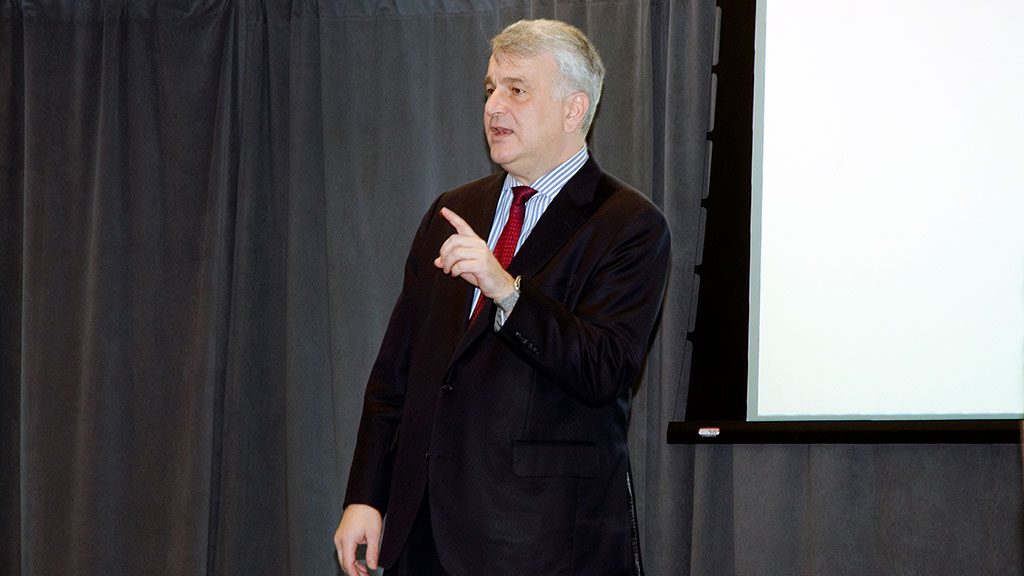Canadian voter rage and populism pose a threat to getting infrastructure projects built.
That was the message from Nik Nanos, executive chairman of Nanos Research Group of Companies, at a Canadian Council for Public-Private Partnerships (CCPPP) event held Jan. 23 in Toronto.
“We should not be naive that people understand the value of P3s,” said Nanos, who is also the author of The Age of Voter Rage. “They want more infrastructure but there are fundamental communications threats. We have to think of how we communicate and engage citizens when we’re trying to advance any kind of project.”
Populism and populist-style politics have worked effectively in every election over the last three years without exception, said Nanos.
“You should be thinking about those successful techniques that populist-style politicians are using and you should ask yourself are you doing that or are you still communicating and connecting with stakeholders and the public the same way you did in the 1970s?” Nanos asked.
In the Ontario provincial election last year, Premier Doug Ford used populist-style communication strategies to distill issues and connect with voters, Nanos noted.
“He kind of smashed the paradigm on what is necessary to win,” said Nanos. “The traditional paradigm is you prepare a platform that is fully costed. It’s a big, thick document. You have all your proof points and you put that in the public domain. He (Ford) was observing and understood what has been working not just in Canada but in other places. He understood that it was symbolic messaging that was actually effective and connected with people such as ‘Ontario is open for business.’ ”
The P3 industry has many lawyers and engineers who take a more traditional approach to communication and stakeholder outreach, Nanos said.
“They think if we just have one more argument we will change the regulators’ point of view. If we just have one more proof point, one more economic study, people in the community will change their minds in terms of the infrastructure project,” he stated. “Evidence-based dialogue is critically important. What I am saying is you need to add another variable.”
While literal messaging such as proving the benefits of an infrastructure project or P3 is necessary, symbolic messaging is also needed as part of what you put out in the public domain. To illustrate the difference, he used U.S. President Donald Trump’s border wall.
“For people that were into literal messaging, lawyers and engineers, they ask questions like ‘How tall is that wall? How long would that wall be? How much will it cost? Will it fulfil our public policy objectives?’ And then they say it’s a stupid idea,” explained Nanos. “For the people that symbolically interpreted what was there, they would say ‘yes, protect jobs, keep foreigners out, keep our borders safe.’ The symbolic messaging is very high level — stuff where no one needs to read the fine print.’ ”
Another issue is the blurriness between real news and fake news, even with infrastructure projects.
“When stupid things are said you should not dismiss it because these stupid things could be repeated, especially in social media,” he said.
Nanos recently conducted research on behalf of the CCPPP to examine Canadian support for P3s, confidence in getting major projects built and views on foreign participation in Canadian projects.
“By more than a margin of two to one, people support or somewhat support P3s for new infrastructure projects in Canada,” said Nanos. “You have to think of voters as taxpayers and consumers. If you are a taxpayer and a consumer and there is infrastructure that you want and you know that the government might not be able to afford that infrastructure, then you are going to say as a consumer ‘I want that infrastructure and as a taxpayer I don’t want a big burden, or I want to control or manage that burden.’ ”
He said 49 per cent of Canadians surveyed opposed international companies bidding on Canadian infrastructure projects while 41 per cent said they support open competitive procurement.
“Nativist” tendencies need to be considered, he noted.
“Hypothetically, if you are an international company bidding on this, from a stakeholder management point of view, having a Canadian partner of some sort helps,” said Nanos.
In terms of making community benefits agreements mandatory for major infrastructure projects, 46 per cent were in favour of having local community benefits and 43 per cent say the infrastructure itself is the benefit.
Canadians are divided when it comes to consultation and balance on infrastructure projects with 27 per cent saying there is good balance between economic interest and those of the environmental and Indigenous communities; 27 per cent saying it’s too easy to build infrastructure; and 37 per cent saying consultation favours environmentalists and Indigenous groups.
He advised those in attendance to watch out for the referendum syndrome, using nuclear power as an example.
“The best way to lose public engagement on nuclear power is to tell people all the benefits of nuclear power and to say that it’s good,” explained Nanos, adding it’s not a beauty contest. “What you need to say is ‘maybe you like nuclear power, maybe you don’t, but compared to other things it does really well’
“You have to think about presenting choices to people and how they benefit from those choices so they are actually making real decisions.”










Recent Comments